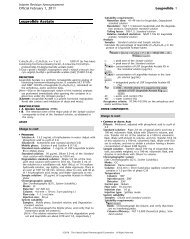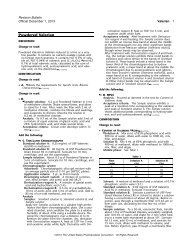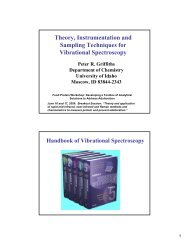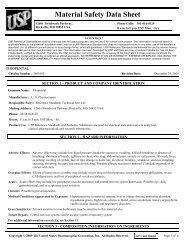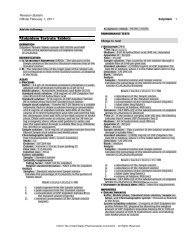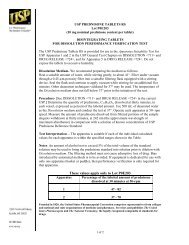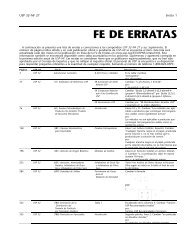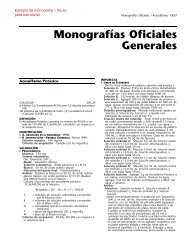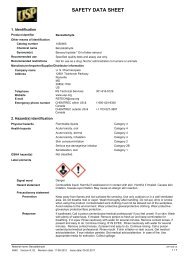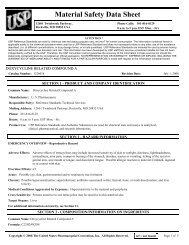〈85〉 bacterial endotoxins test - US Pharmacopeial Convention
〈85〉 bacterial endotoxins test - US Pharmacopeial Convention
〈85〉 bacterial endotoxins test - US Pharmacopeial Convention
Create successful ePaper yourself
Turn your PDF publications into a flip-book with our unique Google optimized e-Paper software.
Stage 6 Harmonization<br />
2 〈85〉 Bacterial Endotoxins Test Official December 1, 2012<br />
Table 1. Preparation of Solutions for the Inhibition/Enhancement Test for Gel-Clot Techniques<br />
Endotoxin Concentration/<br />
Solution to Which Endotoxin Dilution Endotoxin Number of<br />
Solution Is Added Diluent Factor Concentration Replicates<br />
A a None/Sample Solution — — — 4<br />
B b 2λ/Sample Solution Sample Solution 1 2λ 4<br />
2 1λ 4<br />
4 0.5λ 4<br />
8 0.25λ 4<br />
C c 2λ/Water for BET Water for BET 1 2λ 2<br />
2 1λ 2<br />
4 0.5λ 2<br />
8 0.25λ 2<br />
D d None/Water for BET — — — 2<br />
a Solution A: A Sample Solution of the preparation under <strong>test</strong> that is free of detectable <strong>endotoxins</strong>.<br />
b Solution B: Test for interference.<br />
c Solution C: Control for labeled lysate sensitivity.<br />
d Solution D: Negative control of Water for BET.<br />
Units/mL: in the case of endotoxin limit specified by unit positive. A result is negative if an intact gel is not formed.<br />
of biological activity (EU/Unit); The <strong>test</strong> is considered valid when the lowest concentration<br />
mL/mL: when the endotoxin limit is specified by volume of the standard solutions shows a negative result in all rep-<br />
(EU/mL). licate <strong>test</strong>s.<br />
λ: the labeled sensitivity in the Gel-Clot Technique (EU/ The endpoint is the smallest concentration in the series<br />
mL) or the lowest concentration used in the standard of decreasing concentrations of standard endotoxin that<br />
■ ■2S (<strong>US</strong>P35) curve for the Turbidimetric Technique or Chromo- clots the lysate. Determine the geometric mean endpoint<br />
genic Technique. by calculating the mean of the logarithms of the endpoint<br />
concentrations of the four replicate series and then taking<br />
the antilogarithm of the mean value, as indicated in the<br />
Change to read: following formula:<br />
geometric mean endpoint concentration = antilog (Σe/f)<br />
GEL-CLOT TECHNIQUE where Σe is the sum of the log endpoint concentrations of<br />
The gel-clot technique is used for detecting or quanti-<br />
fying <strong>endotoxins</strong> based on clotting of the lysate reagent in<br />
the presence of endotoxin. The minimum concentration of<br />
endotoxin required to cause the lysate to clot under stan-<br />
dard conditions is the labeled sensitivity of the lysate rea-<br />
gent. To ensure both the precision and validity of the <strong>test</strong>,<br />
perform the <strong>test</strong>s for confirming the labeled lysate sensitivity<br />
and for interfering factors as described in Preparatory<br />
Testing, immediately below.<br />
Preparatory Testing<br />
Test for Confirmation of Labeled Lysate Sensitivity—<br />
Confirm in four replicates the labeled sensitivity, λ, ex-<br />
pressed in EU/mL of the lysate prior to use in the <strong>test</strong>. The<br />
<strong>test</strong> for confirmation of lysate sensitivity is to be carried out<br />
when a new batch of lysate is used or when there is any<br />
change in the <strong>test</strong> conditions that may affect the outcome<br />
of the <strong>test</strong>. Prepare standard solutions having at least four<br />
concentrations equivalent to 2λ, λ, 0.5λ, and 0.25λ by di-<br />
luting the <strong>US</strong>P Endotoxin RS with Water for BET.<br />
Mix a volume of the Lysate TS with an equal volume<br />
(such as 0.1-mL aliquots) of one of the Standard Endotoxin<br />
Solutions in each <strong>test</strong> tube. When single <strong>test</strong> vials or ampuls<br />
containing lyophilized lysate are used, add solutions directly<br />
to the vial or ampul. Incubate the reaction mixture for a<br />
constant period according to the directions of the lysate<br />
manufacturer (usually at 37 ± 1° for 60 ± 2 min), avoiding<br />
vibration. To <strong>test</strong> the integrity of the gel, take each tube in<br />
turn directly from the incubator, and invert it through<br />
about 180° in one smooth motion. If a firm gel has formed<br />
that remains in place upon inversion, record the result as<br />
the dilution series used, and f is the number of replicate<br />
<strong>test</strong> tubes. The geometric mean endpoint concentration is<br />
the measured sensitivity of the lysate (in EU/mL). If this is<br />
not less than 0.5λ and not more than 2λ, the labeled sensitivity<br />
is confirmed and is used in <strong>test</strong>s performed with this<br />
lysate.<br />
Test for Interfering Factors—Usually prepare solutions<br />
(A–D) as shown in Table 1, and perform the inhibition/en-<br />
hancement <strong>test</strong> on the Sample Solutions at a dilution less<br />
than the MVD, not containing any detectable <strong>endotoxins</strong>,<br />
operating as described for Test for Confirmation of Labeled<br />
Lysate Sensitivity. The geometric mean endpoint concentrations<br />
of Solutions B and C are determined using the formula<br />
described in the Test for Confirmation of Labeled Lysate Sensitivity.<br />
•The <strong>test</strong> for interfering factors must be repeated<br />
when any condition changes that is likely to influence the<br />
result of the <strong>test</strong>.• (IRA 1-Apr-2011)<br />
The <strong>test</strong> is considered valid when all replicates of Solu-<br />
tions A and D show no reaction and the result of Solution C<br />
confirms the labeled sensitivity.<br />
If the sensitivity of the lysate determined in the presence<br />
of Solution B is not less than 0.5λ and not greater than 2λ,<br />
the Sample Solution does not contain factors that interfere<br />
under the experimental conditions used. Otherwise, the<br />
Sample Solution to be examined interferes with the <strong>test</strong>.<br />
If the sample under <strong>test</strong> does not comply with the <strong>test</strong> at<br />
a dilution less than the MVD, repeat the <strong>test</strong> using a<br />
greater dilution, not exceeding the MVD. The use of a<br />
more sensitive lysate permits a greater dilution of the sam-<br />
ple to be examined, and this may contribute to the elimi-<br />
nation of interference.<br />
Interference may be overcome by suitable treatment such<br />
as filtration, neutralization, dialysis, or heating. To establish<br />
©2011 The United States <strong>Pharmacopeial</strong> <strong>Convention</strong> All Rights Reserved.<br />
Date: 14-OCT-2011 Time: 8:08 (P) \\usp-netapp2\share\SHARE\<strong>US</strong>PNF\PRINTQ\pager\xmlIn\AO_20111014080832_M98830.xml




